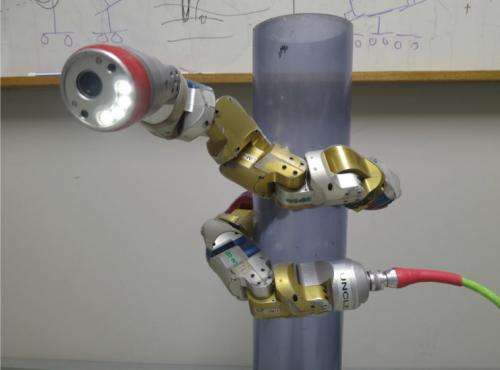Credit: Biorobotics Laboratory, Carnegie Mellon University
(Phys.org) —Researchers at Carnegie Mellon University's Biorobotics laboratory have adapted one of their robotic snakes to cause it to automatically wrap itself around an object after being thrown. Upon impact, the snake immediately wraps its body around the target—in the test cases, a light pole and tree branch, and holds on, supporting itself.
Robot snakes have been developed in recent years to mimic the actions of their real life counterparts. Scientists believe their leg and feet-free mode of locomotion might be ideal for use in hard to reach places, such as buildings that have been knocked down by an earthquake. Thus far, researchers have developed such snakes that are able to travel over terrain in ways very similar to a real snake, and even to climb up objects such as a person's arm. Now, in this new effort, the researchers have extended the capability of a robot snake to include wrapping and holding on to an object when thrown at it.
The researchers were able to give the snake such an ability by making use of accelerometers embedded in its body. It's able to detect the sudden stop that occurs when it strikes an object—after that, it was simply a matter of taking advantage of programming that had already been done by the team to get it to wrap itself around the object that it had struck. The team at CMU is engaged in research involving robot snakes as part of an overall initiative to develop robots that can be used in medical applications, to help manufacture things, as part of archeology efforts, and perhaps most specifically to assist with search and rescue operations.
It's important to note that there is a difference between wrapping and constricting—this robot snake does the former, but not the latter—it doesn't squeeze the target, it simply wraps itself around it to allow it to hold on. Though, it's not beyond the pale to consider that constricting could also be added to the snakes' abilities, especially when noting that the U.S. Army Research Lab is paying for the research. The researchers on the project don't divulge what sort of objectives the Army may have in mind for the snakes and thus any theories on their use (such as, as a weapon) at this time would be purely speculative.
© 2013 Phys.org























